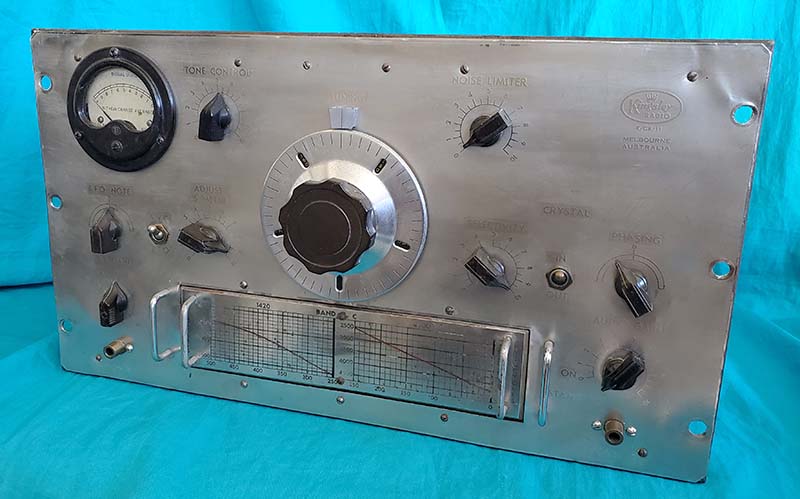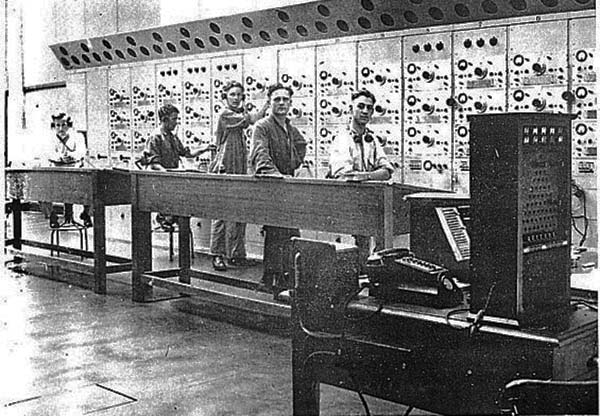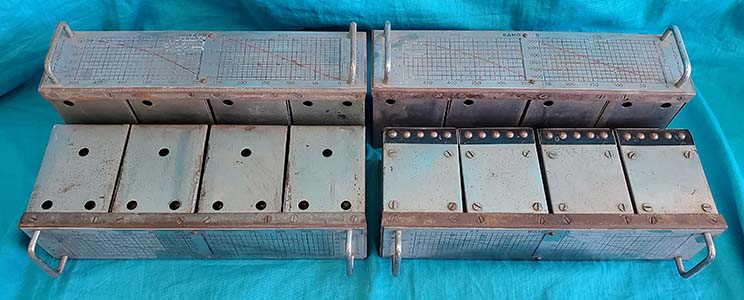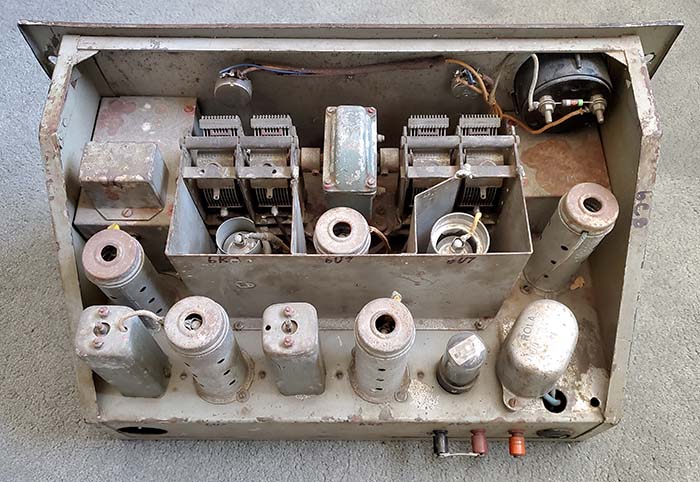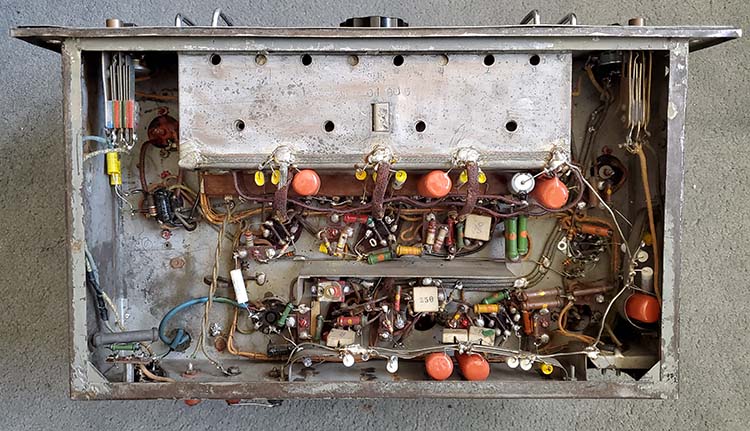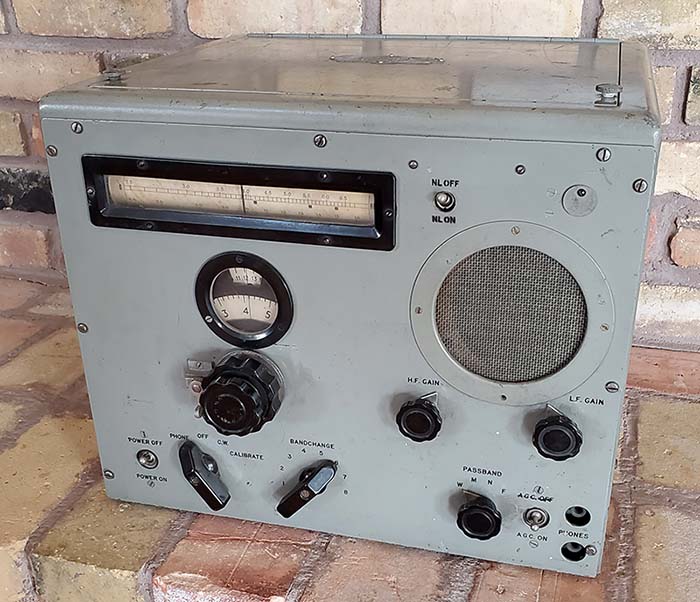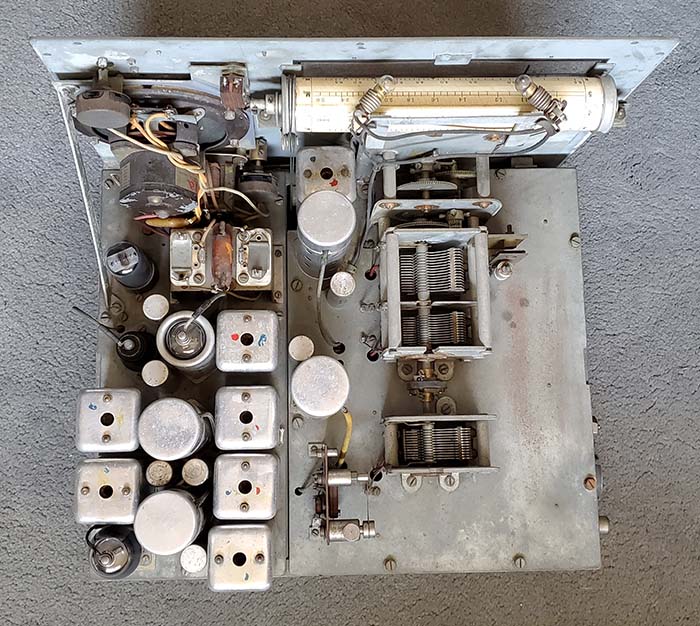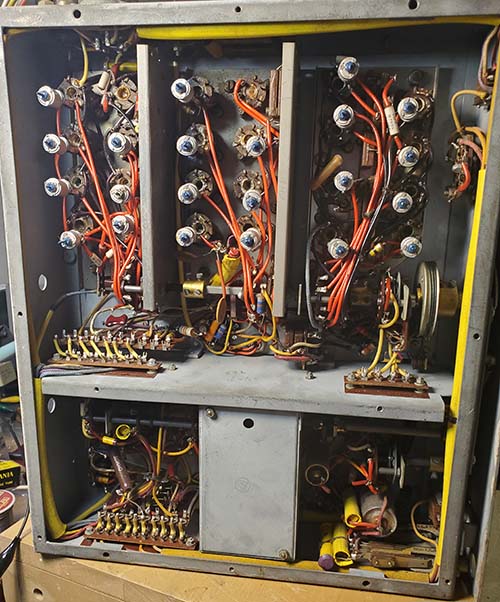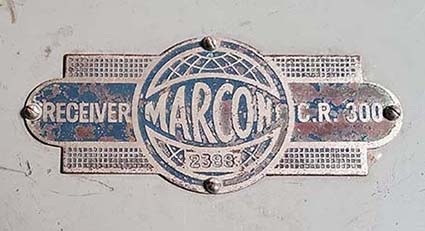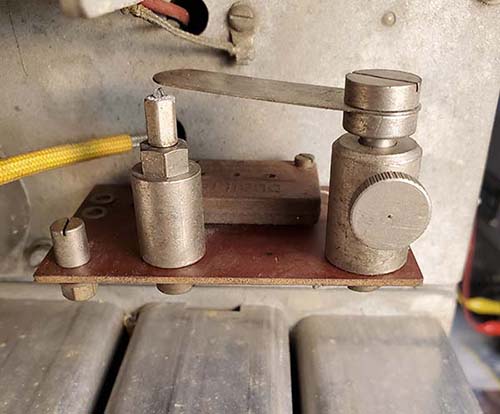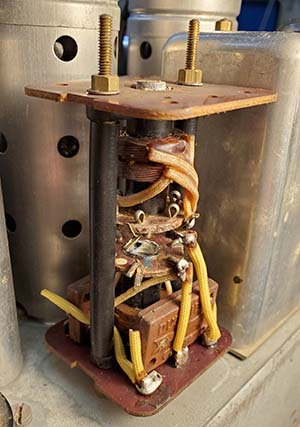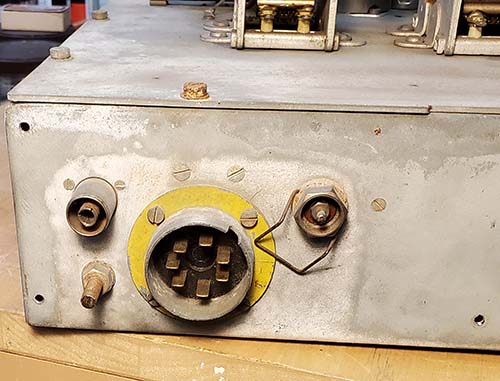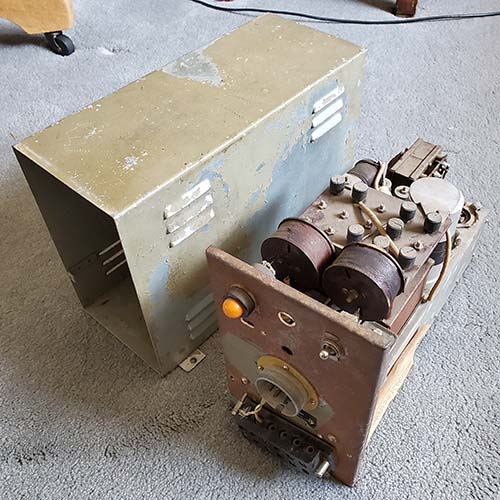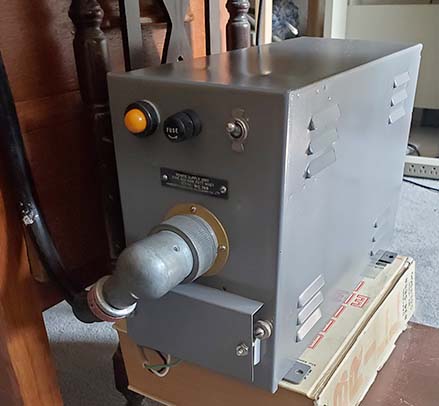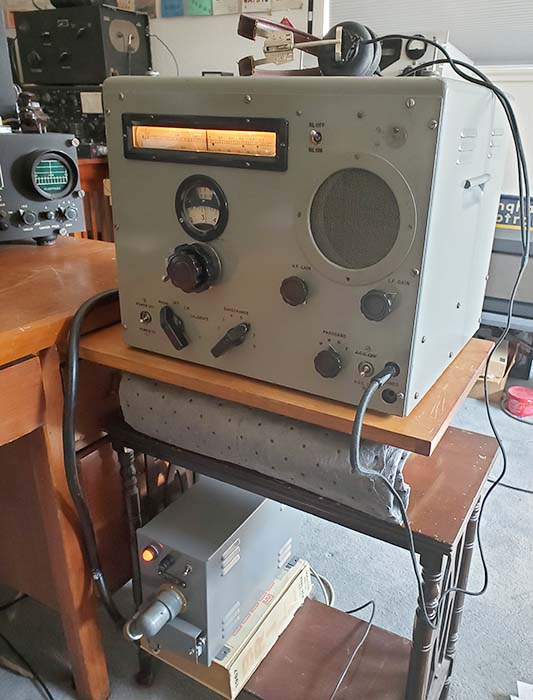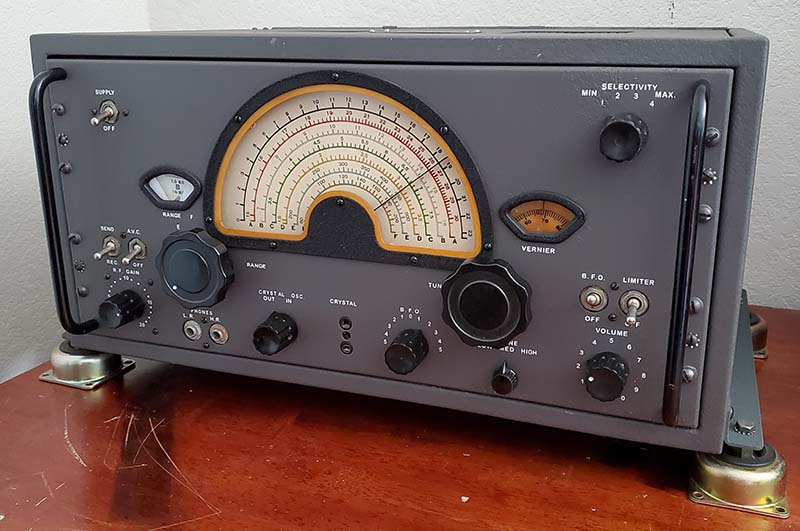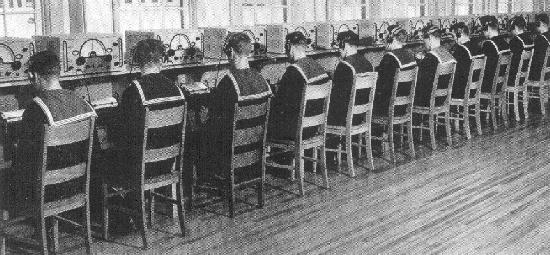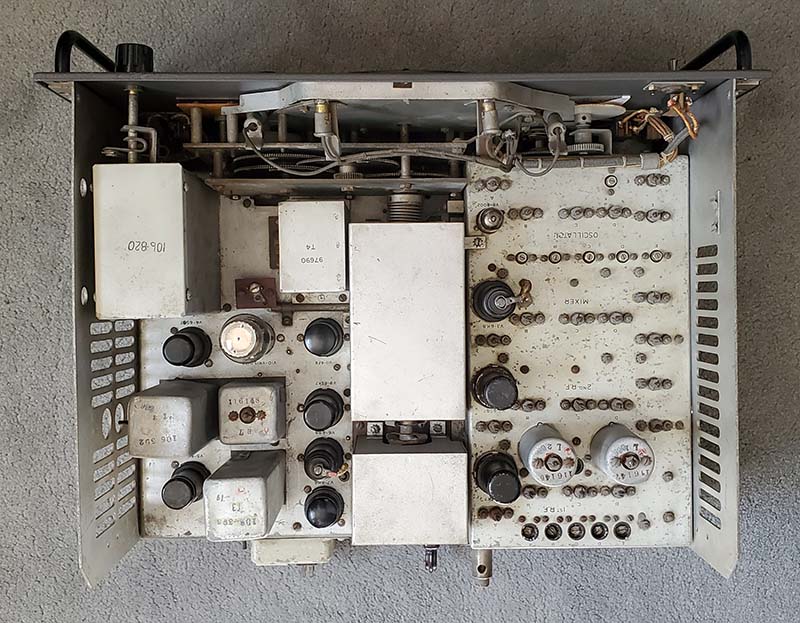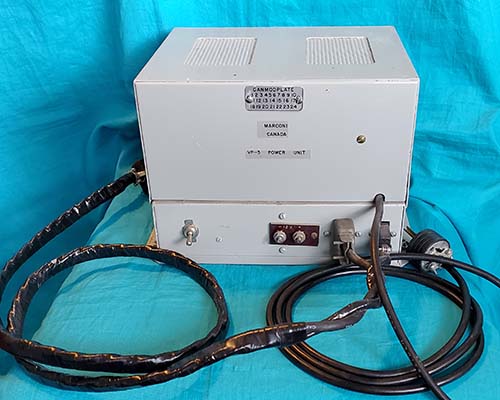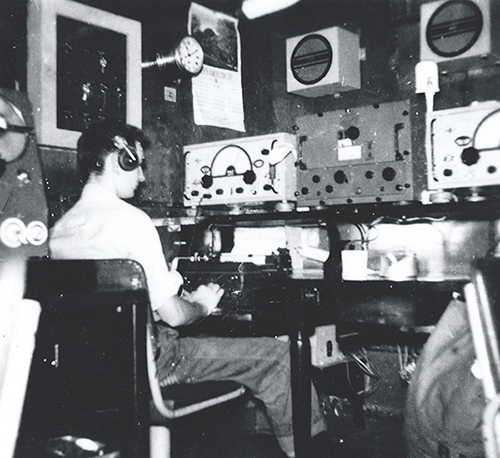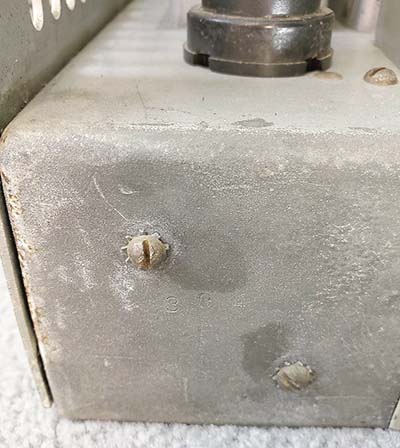|
Single preselection is used with a converter tube circuit and
two 560kc IF amplifiers. Audio output is transformer coupled and
is intended for a Hi-Z headset (5K output impedance.) All
voltages to operate the R1155 are supplied through the T1154
transmitter. An interconnecting cable runs from the transmitter
to the right-most Jones plug, P1, on the lower front panel of the
receiver. The left-most of the Jones plugs is P3 which is for the loop
antenna connection (there's a vari-C trimmer and optional fixed
C inside this plug) and the center plug is P2 for the Visual
Indicator connection (R-L meter.) All
inputs and outputs to and from the R1155 are routed through
these three Jones connectors. Voltages required are +6vdc tube
heaters (parallel connection) and to compensate for 12vdc
systems an external Type 47 Resistance Unit was installed or for 24vdc
systems a Type 52 or 52A Resistance Unit was installed. The
+230vdc B+ and a negative bias of around -30vdc were provided
through the T1154 by one dynamotor-type system power unit
(called a "rotary transformer" in the manual.) The "VOLUME"
control operates as a sensitivity control when the AVC is off (furthest
CCW position on Master Switch MS) and as an AF Gain control when AVC is
selected. The BFO is turned on when HET is switched on. The small panel
hole above the dial next to the METER AMPLITUDE control allows
adjusting the HET oscillator frequency. The small panel hole to
the right of the MS allows adjusting the loop
antenna trimmer. All of the controls along the upper
section of the front panel are for the direction finding
operation. Receiver only controls are Band Change, MS, HET
on/off, Volume and Tuning. The R1155 worked in conjunction with
several auxiliary pieces of equipment that included the Visual
Indicator Type 1, the Loop Antenna compass, the Antenna Switching
panel Type J, Type 192 Mic/Tel panel. Sometimes the setup included two
Visual Indicators at each station (radioman and navigator.) Up
to three antennas could be connected to the R1155, the loop
antenna, the sense antenna and the trailing wire antenna,
depending on the service the receiver was going to perform
(communication or navigation) and on what frequency the receiver
was operating.
The "A" in R1155A indicates that MW filters are installed to
eliminate broadcasting interference at the IF (560kc.) "B"
indicated the receiver had additional filters for operating near
radar systems. There were several designated internal options
available running up to a "N" version. Most variations indicate
SW (radar filters) and/or MW (AM-BC filters) internal filtering,
construction material (aluminum or steel) and in some cases end use. Some
versions were for mobile-land use, some were used in ground
schools and there were two types for
marine use (air-sea search-rescue aircraft.) There were several
types of 230vac 50cps power supplies available for land use.
Some R1155 receivers were built on steel
chassis with steel front panels and steel shielding. These were
undoubtedly for ground
use or installations other than airborne - the steel receivers
are noticeably much heavier than the aluminum receivers. Most
receiver cabinets have five cork panels glued to the inside
recessed areas. The rear inside cork panel has the vacuum tube
locations and tube types shown on a glued-on paper label. |
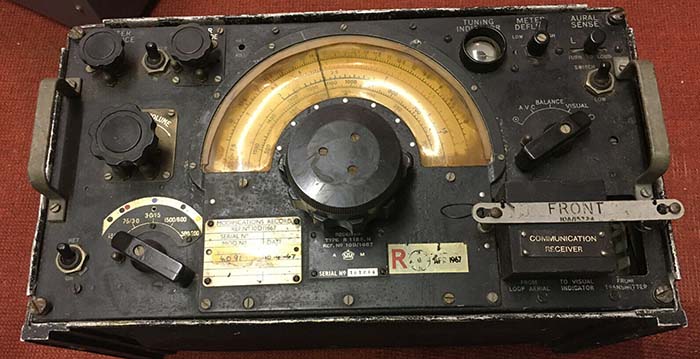
photo above: A very original example of a R1155B receiver
with lots of "use patina."
It appears to be virtually complete and all original although
judging by the "mod plate" (modifications record - the metal tag
to the right of the band switch) this receiver has had several
"upgrades" installed over the years. "B" versions had
internal filters for operation near radar in addition to the MW
filters. Note the
six-digit serial number indicating that production quantities of
R1155 receivers was quite high. Also, note the dates on the
various tags in this receiver,...1967,...this R1155 was in use for quite a
long time after WWII. This example is fitted with the improved
two-speed tuning knob. This receiver is also fitted with the
"blocking plug" that has the "COMMUNICATION RECEIVER"
tag on the front indicating this R1155B was used in a "dual
receiver" set-up where the navigator had the DF R1155 and the
radioman had this receiver and the DF abilities couldn't be used. This receiver also has the Jones plugs
retaining strap installed.
photo from: eBay UK |
| DF
Controls - The R1155 used an external
"cross-needle" Visual Indicator meter (actually two meters
within the unit) to show
visually if the airplane was on-course. First a homing beacon station
was tuned in. Then the receiver was switched to "BALANCE" which
connected an antenna coil into the circuit and METER BALANCE was
adjusted for the two meter needles to be equally in the
"crossed" position. The receiver was then switched to VISUAL and
the loop antenna placed perpendicular with the fuselage
(athwartship) and the airplane steered toward the beacon which
showed the crossed-needles on the meter when on-course. The
pilot would deviate his course slightly and if the
crossed-needles moved off-center-downward the beacon was behind
the airplane. The pilot would turn around, the course aligned
and then any deviation moved the needles off-center-upwards,
indicating the beacon was ahead. As the airplane approached the
beacon the signal would get stronger and METER AMPLITUDE was
adjusted to keep the crossed-needles near the center of the
field. METER DEFLECTION HIGH-LOW changes the sensitivity of the
meter depending on the signal strength of the beacon.
Alternately, if a specific direction of an unknown signal was
desired, such as in a "search and rescue" operation, then the
receiver was switched to the horizontal figure-8 position (loop
antenna only) which then allows a bi-directional response to the
signal as referenced to the loop's position relative to the
airplane's fuselage and its direction of flight travel, to be
determined. With the signal tuned, the loop antenna is rotated
watching the TUNING INDICATOR (eye tube) looking for a minimum
signal which would be one of the bi-directional nulls. The loop
is then rotated +90º and the AURAL SENSE pushed to the
right, if the signal is reduced in strength then the signal's
location is toward the front of the aircraft fuselage (if the
loop and compass are set for 0º being the nose of the
aircraft.) If the signal increases
instead,
then the loop is rotated +180 degrees, the AURAL SENSE pushed to
the right again and the signal should decrease indicating the
correct signal location is in front of the aircraft
fuselage. Alternately, true
direction can
also be determined by alternately pushing AURAL SENSE both L and
R, which ever produces the lowest level signal is the correct
direction of the signal origin in relation to the aircraft
fuselage and the aircraft's course bearing. The SWITCH SPEED changes the multi-vibrator
switching rate at the modulator circuit with the combination of
the phase-shifted loop with the sense antenna. The meter drive
output and mixer circuit uses the multi-vibrator speed in
combination with the receiver detector output indicate a phase
change between the loop and sense antennas (caused by the
airplane's course versus the path of the beacon's signal) that
then drive the meters indicating right or left of the aircraft
position. The speed
settings are LOW 30hz for a voice beacon (like using
an AM-BC station as a beacon) or up (high 80hz) for a CW or
tone beacon. For more detailed DFing and navigation
information go to the "USN & USAAF Airborne Navigation
Equipment"
Part 2 of WWII Radio Communications Equipment. |
| RAF Modifications
- It's common to find complete and original R1155
receivers that are missing V1,V2 and V9. When the radioman's
receiver was paired in the airplane with a navigator's R1155, then these three
tubes were removed from the radioman's receiver. These were the three
main DF tubes and if the receiver was just to be
used as a "receiver," V1,V2 and V9 were pulled to drop the tube heater
current requirements (900ma drop, almost an amp.) The tube
heaters are wired in parallel so pulling tubes that weren't
needed wasn't a problem. Also, a dummy plug (called a "blocking
plug") was inserted for the
loop antenna cable and the Visual Indicator cable when the R1155
was just to be operated by the radioman.
Nowadays, if the missing tubes are going to be replaced, V1
and V2 are CV1099 tubes that are
inexpensive and easy
to find. V9 is a dual triode, VR102/BL63, of which the USA equivalent is the
6F8G. Audiophiles have driven the price of both the 6F8G and the
VR102/BL63 into the stratosphere. Why? Because the 6F8G is the
pre-WWII predecessor to the ubiquitous 6SN7 dual triode for which audiophiles
will pay exorbitant sums of money (for certain variations of
manufacture.) In the USA, it's probably easier
(less expensive anyway) to find a 6F8G at about $20 to $50 (for
used/tested good) rather than to try and compete with the
audiophiles for a VR102/BL63 at over $100 a piece. |
Amateur
Modifications - Like the BC-348 here in the USA, there
are a lot of surviving R1155 receivers in the UK today. But,
also like the '348 in the US, a complete and all original R1155 is
a rarity and
difficult to find. The R1155 was available on
the British surplus market for very low prices starting in the
mid-to-late-1950s.
And, like the hams in the USA with the BC-348, the British hams bought the R1155 as an
inexpensive way to obtain a decent receiver and then "modified" the
R1155 to suit their needs. Most often the direction finding circuits
were entirely extracted from the receiver since they weren't going to be
needed but the space they had occupied on the chassis was going to be needed
for their ham mods. With the right side of the chassis nearly vacant, an AC power
supply was generally built into the receiver. There were other mods that were
published in the British ham magazines of the time that advocated even
further destruction of the receiver's originality. The result is that today, like the BC-348
in the USA, very few "complete and original"
R1155 receivers exist. |
|
|
A Minimally Modified Example -
Mods to SN:34471 SN:34471 appeared to be
very good looking example that was complete and original, that
is, until it was examined in detail.
Here's a list of the types of mods that might be found in almost
any R1155 receiver that seems to be "all original" and that
assessment is based on using photographs or a cursory visual
examination for the inspection process. Not that I'm
complaining! This receiver was very easy to return to
original. |
| 1. V1 & V2
Grid Leads Mod - V1, V2 and V9 were missing which
wasn't too surprising. A close look when installing a couple of
CV1099 tubes for V1 and V2 revealed
that the grid cap wires for these tubes were gone. Wire was
"cut" from junction of C56 and R57. New grid
leads made with rubber insulated wire to correct. 2. The grid lead for V9 was still
present but had been wrapped with friction tape to insulate.
Removed tape and installed grid lead on the 6F8G that was
installed for the V9 function.
3. Trailing
Ant Mod
- R62 (static drain R)
was disconnected from pin 2 of the P1 Jones-type receptacle.
This resistor was in place to drain static build-up from the
trailing wire antenna.
Resoldered R62 for originality.
4. HET OSC Mod
- It was noted that a couple of
non-original looking wires (bright orange and blue plastic
insulation) exited the BFO box on top of the
chassis. Tracing the two wires revealed that it was a mod that
parallel-connected an air variable with the HET ADJ condenser
with a non-original air variable C mounted in the METER BALANCE
position. This mod was to provide a front panel BFO control.
This mod resulted in a missing R51 (a 20K linear taper pot) that was for the METER BALANCE
circuit.
Luckily, the three wires that
were connected to R51were still present. Desoldered
orange and blue wires and removed. Removed non-original air
variable C. Installed vintage 25K pot and connected original
wires.
5. A
non-vintage 18.2K WW resistor added to the switched B+ in series
from HET switch to the BFO tube circuit. This may have been to reduce the BFO level (for
weak CW stations)
or it may have been to compensate for the addition of Mod #4.
Removed WW resistor and reconnected original wire to HET switch.
>>>
|
>>> 6. V9 Mods
- There appeared to be some modifications that were never
completed involving V9. A small audio output transformer was
mounted under the side rail. Only one end of the primary winding
was connected to pin 3 of V9. There were no other connections to
this transformer with the opposite end primary wire not being
connected to anything. The secondary was shorted together with a
jumper. Perhaps it was going to be used as a choke. The original
wire from pin 3 to L26 had been cut and removed. R65, a 10K
resistor, was disconnected from pin 5, one of the grid inputs on
V9. The jumper wire between V9 cathodes, pin 4 to pin 8, had
been cut. Installed new wire with rubber
insulation to replace missing pin 3 to L26 wire. Reconnected R65
and resoldered cathode jumper wire. 7. Multivibrator Speed
Switch - wasn't an original component. Made in
USA toggle switch.
Removed non-original switch and replaced with
an original R1155 toggle switch.
8. Nomenclature Plates
- I wondered about the gold color on the Band Change, MS,
Logging Scale plates and the SN plate. I closely examined each
and they are original. I believe the paint was worn off because
these are the most used controls and the radioman was probably
wearing heavy insulated gloves that tended to "scrub off" the paint and
"polish" the base metal. I think the serial number plate is
another matter. It appears original and was probably "over
cleaned" during an earlier restoration.
Luckily, these mods to SN:34471 didn't remove very much of
the original circuitry or too many original components. Return
to the original circuit and configuration was easy to accomplish.
More details further down this write-up in "Getting SN:34471
An Original Example R1155 Operational." |
|
Original Example
with Aluminum Construction |
|
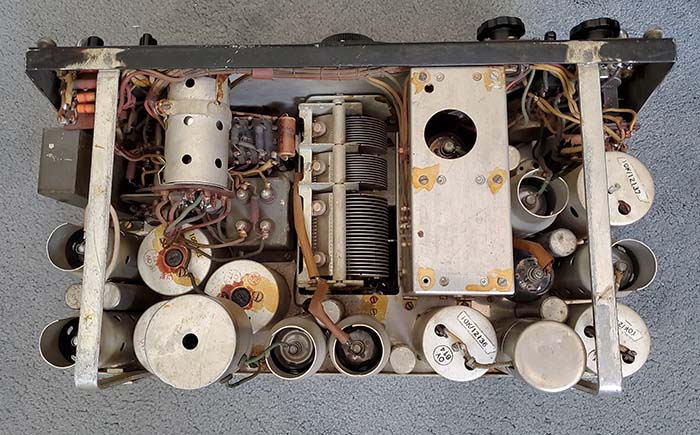
| Top of the chassis on SN:34471. The
construction is all aluminum. The cylinder that is
mounted over the MW RF coils is the MW filter
which is a wave trap network for 560kc. The two tubes on the far left
are the loop amp/multivibrator tubes. Behind the tuning
condenser are the RF amplifier and Converter tubes. In the shielded
compartment is the BFO/AVC tube. The upper most tube
to the right of the shielded compartment is the Detector, Meter
Limiter and Audio Output tube. The next tube down is the R-L
meter amplifier and to the right of it is the 2nd IF amplifier. The
tube with the shield cap is the 1st IF amplifier tube. The horizontal, panel-mounted tube is the
tuning eye tube. |
|

| Bottom of the chassis on the same
receiver. Full shielding for the HF RF section and band switch which are within the aluminum
shielded box. Note the right-angle gear drive for the band
switch (actually easier to see in the lower photo.) As can be
seen in this photo and the photo to the left, the
original wire used had natural rubber insulation that
does have a tendency to dry-out and become brittle. This
receiver was apparently kept indoors for its entire
existence since the rubber insulation is still pliable
and supple. Many R1155 will have already had some or all
of the wiring replaced as repairs or restorations. Other
receivers might need this done as part of the rebuild.
Note on the left rail that there are two drilled holes.
There was a small audio transformer (not connected into
the circuit) mounted there. |
|
|
Modified Example
with Steel Construction |
|
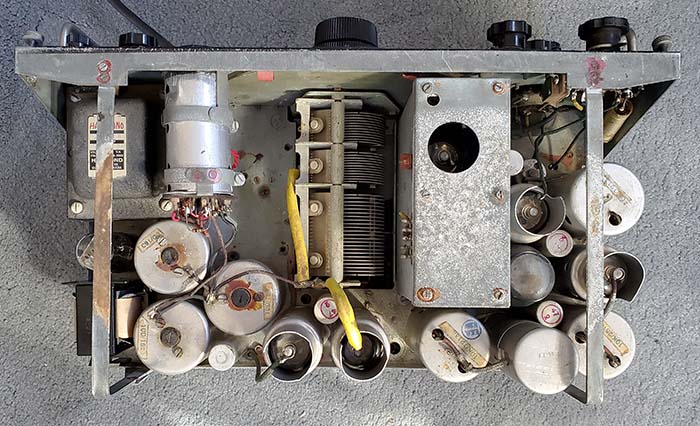
| This is the top of the chassis of
SN:68154 showing how the steel construction appears.
Note the corrosion on the cover of the BFO tube housing and the
rusted area on the left rail. Where the chassis can be seen it
has some spotting. This receiver has been severely modified.
Note the Hammond power transformer upper left and below it the
5Y3GT and the filter choke. Also, compare this chassis to the
one in the photo above (SN:34471) to note how many of the
original components are missing. The large glass tube to the
right of the BFO housing is the added 6F6 audio output tube. |
|
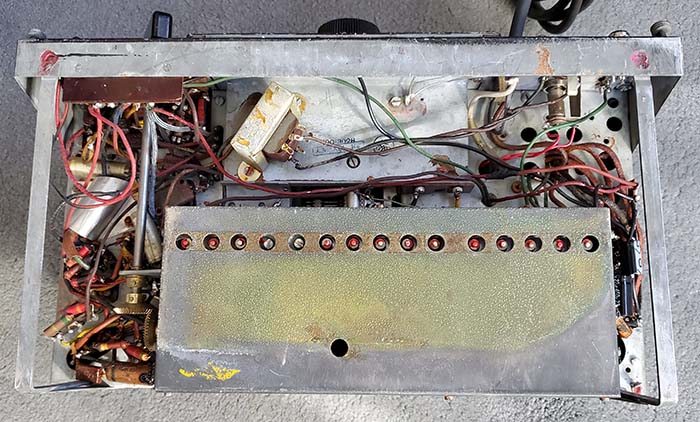
| Apparent is a strange yellowish
corrosion on the steel shield over the band switch
compartment. Compare this chassis photo to the one above
to note how much of the original circuitry is gone. The
transformer mounted upper center is the Lo-Z audio
output transformer that provides an 8 ohm output from
the 6F6 output stage. Much of the original rubber
insulated wire has been replaced in this receiver. |
|
|
A Ham
"Extremely Modified"
Example SN:68154 Here's a R1155
receiver that has had just about everything involving the DF
circuits removed
from it and even more done to the remaining circuits. Even the serial number
identification plate doesn't match the receiver. What makes it unusual is that
this receiver is the "steel construction" version so it wasn't
used on aircraft but was a ground receiver. |

photo above: R1155 sn:68154 is typical of the majority
of surviving receivers. Severely stripped of its DF circuitry
and "input-output" Jones connectors to install an AC power
supply. The actual identity of this receiver is questionable
since its chassis and panel are steel making it actually a "D"
version. It's unknown why the "A" version tag is installed. The good thing about this receiver is that it was
bargain-priced ($38+shipping.) Though its originality has suffered, this receiver has
been somewhat resurrected and is now operational as a receiver only. |
To the left is a R1155, tagged as SN:68154 and
ID'd as an "A" version. The receiver's ID/SN plate indicates
the receiver is a R1155A but it's built on a steel chassis with
a steel front panel and steel shielding. This receiver is
actually a R1155D which was the early steel construction
version. Even though the DF section was "stripped out" it
appears that there never was a MW filter installed indicating
the receiver is the "D" version.
The Mod Rundown,...
1. Removal of all DF
circuitry, wiring and components - All DF
controls removed. Much of the hardware was also removed and discarded. Most
original knobs gone.
2. Antenna input
- This is a brown bakelite binding post terminal-type that was
"hacked" into the upper right side of the panel.
3. MS (Master Switch) Relocation
- Of note is the vacant MS area. The switch was moved
to allow the installation of the power transformer which is
located directly behind the panel where the switch had been. The
MS was moved to the METER BALANCE (pot control removed) location (upper left side of the
panel) and only two positions were wired - AVC and Manual Gain with BFO
on.
4. Power Input Changes and Electrodynamic Speaker Intentions - The Jones connectors were
entirely removed and an aluminum plate
installed. The four pin tube socket had been intended for an electrodynamic
speaker with the field coil doubling
as the power supply filter choke. The AC power ON switch
is the only original type R1155 toggle switch. SN:68154 was
modified in Canada so the power transformer used for the AC
power supply was a 115vac primary type built by Hammond. AC
power cord exits out the front of the panel.
5. Lo-Z Audio Output with
a Boost - With the VR102 dual
triode R-L meter driver removed, a 6F6 audio output stage had
been added at that location. A Lo-Z audio output transformer was added after the
original Hi-Z audio transformer had been removed.
6. Logging Scale
- The
Fine Tuning logging scale was removed sometime in the past.
7. Cabinet Destruction
- Two one inch diameter holes were punched in the top of the
cabinet. Nine one inch diameter holes were punched in the right
side of the cabinet. A common hamster thought fallacy that the
onboard an AC power supply
and a high power audio section would get so hot that complete
cabinet ventilation was going to be necessary.
|
| Mod Makeover
- I had to perform a few minor repairs to get the receiver
operational but these were just small problems that had developed over
the years of moving and storing and then shipping the receiver (from
Arizona to Nevada.) The
majority of the serious rework was correcting the mod-design flaws and
basically making the mod changes a bit more professional-looking.
I replaced
the amateur-looking raw aluminum subpanel in the lower right section of the main panel with a
new black wrinkle
subpanel.
I also removed the old brown bakelite dual post antenna terminal
and filled the non-original holes with epoxy and painted over to
hide the fill. I added military-style Antenna-Gnd push terminals
on the new sub-panel (although for a Brit receiver they should have
had "A-E" and "E"
engraving.) I added the red
jewel pilot lamp because the R1155 has no visual indication
that the power is on (the dial is not illuminated.) I replaced the
1920s-era phone jack with a single circuit
phone jack with a
toilet seat cover that's marked "Speaker 2nd Audio" - both jack and seat were out
of the BC-342 junk box.
I eliminated the four pin tube socket and discarded the idea
of using an electrodynamic speaker. I rebuilt the AC power
supply to use a filter choke instead and to have the audio drive
a PM speaker. The mod had used a 5Y4G rectifier tube and it was
found to be defective. I rewired the socket to use a 5Y3GT which
is much easier to find and physically smaller. The defective
can-type multi-section electrolytic (not original) was removed
to have room to install the filter choke. I then used two new
axial-type electrolytics mounted under the chassis. I left the
AC power cable exiting out the front because any other exit route would
further destroy the already seriously damaged cabinet.
>>> |
>>> I had to leave the MS in the Meter Balance
location since the power transformer prevented moving it back to
its original location. I did move the HET wires from the MS and
repurposed a vintage toggle switch to now
separately operate the HET (BFO) from the correct location.
The "re-do" did require some rerouting of the "mod routed"
wires. Many of the wires had rubber insulation which has a
tendency of drying out and then falling off whenever the wire is
flexed. I had to replace several wires that were in this
condition. The dial cover was removed and thoroughly cleaned
which improved the transparency of the original convex plastic.
The dial scale was also cleaned which greatly improved the dial
appearance. A new gasket was made for the mounting interface.
Most of the vacant holes were fitted with control knobs even
though all are "dummy knobs," that is, just for appearance.
Since the receiver was far from original I painted-over the yellow
hand-painted
lettering.
Mechanically, the two-speed dial knob assembly needed
a complete overhaul in order for it to function as intended. The smaller
front
knob is 1:1 "fast tuning" and the larger back knob is 1000:1 "extremely fine
tuning." The conical drive wheels had been greased and the cork friction
gasket was also greased. Needless to say, the drive wheels didn't move
the reduction plate until all of the grease was removed and all
surfaces thoroughly cleaned. This two-speed tuning knob was a
constant source of problems when the receiver was in use during
WWII probably because the reduction drive relied on friction
only. By mid-WWII an improved replacement tuning knob was
available. However, not many R1155s had the improved two-speed
knob installed so this example does have the commonly
encountered,
older, problem-prone, original two-speed knob installed.
|
|
General Performance
- Overall, the R1155 performance results will depend on the
operator's expectations and experience with vintage gear, the operator's QTH and the antenna
used. The R1155 is a capable receiver as far as sensitivity is
concerned and a resonant or tuned antenna will allow excellent
reception of most HF signals. Audio is for phones but SN:68154 had a 6F6 audio
output stage added so it easily drives an 8Z loudspeaker. BFO
provides enough carrier for either CW or SSB copy and the
"extremely fine tuning" function allows easy tuning of those CW
or SSB signals. The tuning eye tube only functions on AM
signals. The IF bandwidth is
fairly broad and not really adjustable. For its use on an
aircraft during WWII, sometimes with the plane being shot at,
narrow bandwidth would have been a disadvantage. If the radio op
needed to change frequency under those conditions and was
searching for a homing beacon signal, a broad IF would make finding
such a signal easier. Also, at altitude the interior of the
airplane was cold and the radio op wore flight gear that
included insulated gloves which made any "fine tuning" nearly
impossible (sometimes it was a "gloves off" operation performed
as quickly as possible.) The lack of a crystal filter or other means to
narrow the IF bandwidth isn't surprising. For what is essentially a "one RF
amp, converter and two IF amps" receiver, the R1155 does a
surprisingly good job. Though, if up against the BC-348 with its "2 RF
amps, Mixer, LO, three IF amps and a Crystal Filter," the R1155
would probably come in second as a radio receiver in such a
comparison.
The R1155's desirability nowadays probably
isn't its performance as just a receiver. The original R1155, with
its ability to DF with its associated
rotatable loop antenna and sense antenna, its ability to drive an external R-L indicator meter and also
perform adequately as a radio receiver make the "complete and
original survivors" the most
interesting and desirable versions. However, the majority of R1155s
didn't make it past the hackers that, in their enthusiasm to perform yet
another
"surplus to ham radio conversion," have relegated most of these
historic receivers to
a "relic" status. |
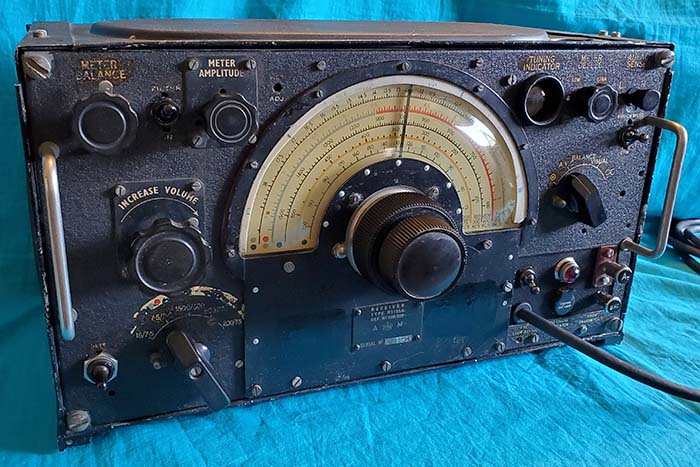
The photo above shows R1155D SN:68154 after reworking was
completed. I think it looks a lot better than it did,...and now
it functions quite well, but just as a radio receiver. In car
collector parlance, one can think of SN:68154 as the "daily
driver" - kinda beat so you don't really care if it gets a
scratch or two. Then SN:34471 is the "all original, only trailered to
shows" example that looks really good but might not run all that
well. |
|
Getting SN:34471, An
Original Example R1155A Operational
The basic return to original was covered in
the section "A Minimally Modified Example" above. Here's
some more
work necessary to actually have an original example also become
functional. |
| Jones Plugs
- The original plugs were basically Jones style connectors.
Where they differed was how the cables were routed as they
exited the plug shell cover. Original British plugs had the cables exit out
the bottom of the plug cover. A cable clamp fitting was
installed on the bottom of the plug cover that further routed
the cable back under the receiver. Modern Jones plugs work and
fit perfectly but the modern plug covers have the cable exit
directly behind the plug at the center-back of the cover. To
make my modern Jones plugs look more like the originals I had to
do a few modifications. First, for the Loop Antenna plug, P3, I
used an eight pin male plug and removed the locating pin which
was slightly off from the original location and then also
removed four of the blade pins so P3 would be a four pin male
with a long body. The long body is necessary because inside the
back cover is a variable trimmer capacitor and a fixed-value
capacitor that connects to the pins of the plug. These
components were used to trim the airplane loop antenna, cabling and routing to
match the receiver loop input impedance. For all three modern plugs the cable clamps were removed
and then the rolled metal trim around the hole was
removed with a file. The back hole was then covered with a "butch
plate" made from .030" aluminum. The aluminum cover piece was
mounted to the rear cover using four 2-56 screws and nuts for
each cover piece. A new .437" hole was drilled into the bottom
side of each cover. Next, the "butch plate" covers were mounted, cleaned and
then painted black wrinkle finish. Rubber grommets were
installed into the bottom cable exit holes. I didn't install the
modern cable clamps since they were nothing like the originals
and wouldn't allow routing the cables directly back under the
receiver.
Wiring P1, P2 and P3 Jones Plugs
- P1 is the right-most Jones connector. This is the input access
for providing tube heater voltage or 6.3vac (originally 6.0vdc
in the aircraft which depended on the drop provided by the external
resistance unit used.) Also, about +230vdc for B+ and about -30vdc for
the bias needs. Additionally, antenna inputs for both the
trailing wire antenna (for MW reception) and the fixed antenna
(for SW reception.) A chassis connection is also required. The
audio output also is from P1. The audio is 5000Z and runs at
'phones level. All receiver voltage inputs and the audio outputs are
accessed at P1. P3 is just for the loop antenna input. The plug, as
mentioned, has a trimmer capacitor and a fixed-value capacitor
inside to match the entire loop and cable impedance to the
receiver loop antenna input. P2 is just for the Visual Indicator connections (the
"crossed-needles" R-L meter.) >>> |
>>> I couldn't find any vintage photos that showed how the
original cables looked. In all installations it appears that the cables
were routed under the receiver then behind the receiver up and
under the T1154 transmitter and then up to the T1154's lower
front panel connectors that are also Jones-type receptacles. The Visual Indicator and the Loop Antenna also appear to
connect from behind each of the devices. The antenna cables from
P1 usually connected to the antenna switching panel Type J.
Nearly all cabling is not really very visible in the original
photographed installations.
A Test Cable for P1
- I made the six wire cable about five feet long. Since this
operation was still in the "test mode" I didn't bother to
install a shield or to wrap the cable. Also, since this was for
test, I tied the two antenna inputs together. I connected the P1
Jones plug to one end and tinned the stripped and bare wire ends on the other end
of the cable. The tinned ends were for easy "test" connections
to the Lambda Model 25 bench supply that provides 6.3vac at 3
amps for the tube heaters and adjustable B+ that I set for
+220vdc. I also connected a small bench supply to provide -25vdc
for the bias voltage. I used a set of Western Electric 518W Hi-Z
'phones for audio reproduction. I connected the antenna lead to
an indoor ten foot "test antenna." Upon applying power I was
surprised to hear a good signal background noise through the
'phones with the receiver tuned to approximately 350kc. I
switched over to the AM-BC band and tuned in several stations. No hum and no distortion.
The VOLUME control is very noisy in operation, the HET OSC is way off
(from the mod that paralleled an air variable for front panel
BFO) and the "eye
tube" is black (well with some imagination, maybe just
perceptibly "dark" green.) All in all, a good "first test."
The "eye tube" is a VR103 (CV1103,) something like a 6G5 but with an
octal base. The eye tube in SN:68154 was somewhat dim but still
easily visible in average room illumination. I swapped the
relatively good VR103 with the dark tube from SN:34471. The HET OSC was just a blade screw driver adjustment. With the receiver
in MVC/HET operation the VOLUME control is a RF gain adjustment
and the noisy operation ceased. I added another wire to the
cable so I could separate the antennas. The trailing wire
antenna went to the "test antenna" since it was for MW coverage. I connected the outdoor wire, a
135' "T" antenna to the fixed antenna input for SW and was able to tune in hams on 40M and on
20M along with SW-BC stations in the 25M band. More to
come,... |
| Building a
Dedicated Power Supply for the R-1155 - Three
voltages are required to operate the R-1155. The tube heaters
can be operated on 6.3vac with about 3 amps of available
current. The B+ can be anywhere from +190vdc up to about +230vdc
with about 65mA of current available. A bias voltage of -25vdc
to about -30vdc is required also.
A filament transformer can be used for the tube heaters or a
power transformer with a filament winding rated at 6.3vac 3A
would also work. By elevating the CT of a full wave rectified B+
power supply, a negative voltage can be created for the bias
voltage requirement. This can be accomplished by connecting the
CT through a resistor to chassis. An adjustable "slider" WW
resistor could be used and then the bias voltage could be
adjusted for best performance (the bias level needed is
dependent on the level of B+ used.) The B+ power supply
filtering must have the negative connections to the CT which is
also B- for the input filter capacitor. If choke input is used,
then the first filter capacitor negative should be connected to
B-/CT. The filtering used will determine the
negative connection of the second filter capacitor. With
pi-filters, the second negative should connect to chassis, if
the filter is dual-section, then the second capacitor negative
should connect to B- and the third capacitor negative should
connect to chassis. |
Parts Located
- I bought a small collection of R-1155 parts from an EBay
seller in Britain. This little collection in a plastic bag
supplied an original plug-retaining post for the left side of
the plug bay. There were also a few knobs and other small
hardware spares that might be needed in the future. |
|









